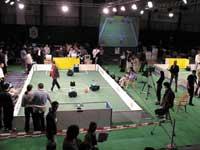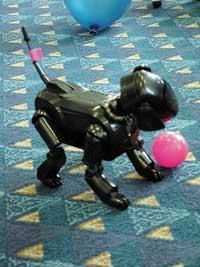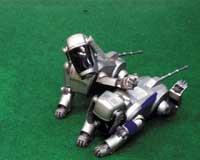Robots also dominate football

The International Robot Football Tournament was created with the aim of promoting and promoting research in Artificial Intelligence, so that researchers working in it become familiar with the appropriate topic and environment. If the main objective is to develop a tool that allows you to make decisions for yourself and develop in the physical environment, hardly a challenge better and more fun than team football.
The first idea to create the group is from 1993. After two years of feasibility study and testing, it was first held in 1997 in Nagoya, Japan. More than 40 groups participated in the first Popular Group Choir. The second world championship was held in Paris in 1998, with more than 50 teams. Last year 120 groups of the Stockholm People's Group met in the Popular Group of Peña Cup2000.
In the robot football championship 6 categories are distinguished:
- League Simulator: Simulation of a football match over the internet. Each team consists of eleven participants who must develop Artificial Intelligence programs so that each player has their own strategy.
- 4-foot Sony Robot League. Using an Aibo robot, created by Sony, contestants must create programs to govern it.
- F180 League: small autonomous robots (15 cm in diameter) must play football on a field the size of the ping-pong table.
- F2000 League: Medium size autonomous robots (50 cm in diameter) play the match in a field of 9 x 6 m.
- LinearCup Junior: simplified version designed by the LEGO house for high school students.
- Two-foot league: this year, for the first time, two-foot robots with a human shape of about 75 cm in height have tried to play football.
The improvement recorded in the four years has been remarkable. In 1997, the robots of{ Cup did not locate the ball from side to side and could also see goals entered in their doors. This year's Peña Cup robots have also been able to cross the ball and make a certain strategy game.

And how is the football match between robots? When the match starts, robots work on their own, nobody controls them. In the F-2000 league, for example, each team consists of 4 robots rolled up to 50 cm. The football pitch is a 6 x 9 m carpeted area shaped like a normal football field. Robots can communicate with each other via radio signals, but people have no right to intervene in these signals. They usually have a goalkeeper and the rest are strikers or strikers, as in normal football. The duration of the match is two parts of 15 minutes.
The ball is orange and is yellow and its circular shape is used by robots to detect the ball. Therefore, it is not allowed to take pictures of flash. Viewers can't wear orange clothes either if they don't want robots to follow them!
The advantage of reference projects like the Popular Group is the advancement in engineering and technology around a common goal. To train robots in football, researchers face other technologies:
- Design the principles of autonomous agents.
- Collaboration between different agents.
- Acquisition of new strategies.
- Reasoning in real time.
- Robotics.
- Sensor development.
- Development of new materials.
In this way, robots will serve to work in the future their skill in other areas such as:
- Robots for hazardous jobs and environments: cleaning radioactive zones, removing mines and pumps, underwater and space exploration.
- Rescue: find survivors after the earthquake, rescue endangered swimmers, rescue in avalanches.
- Develop future autonomous transport systems.
- Design doll robots for play and education.
- Improve the teamwork of industrial robots.

According to the organization, the XXI. In the middle of the 20th century, robot football teams, following current FIFA rules, will be prepared to defeat the world team of football champions made up of people.
By the way, reader, would you like to know who has won this year's world championship? In the F2000 league (main league), Germany's CS Freiburg and Italy's Golem Team tied three and the Germans beat 6-4 after the penalty.
This year, people from all over the world have participated. Among them were those of the University of Girona on behalf of Catalonia. Will the Basque team soon have a selection of their robots?
The next world championship will take place in Seattle. You are still in time to adapt your robots, team up and participate in it.
Published in 7
Buletina
Bidali zure helbide elektronikoa eta jaso asteroko buletina zure sarrera-ontzian











